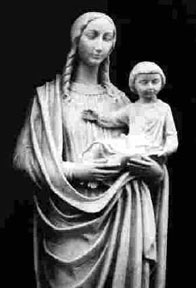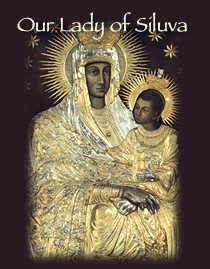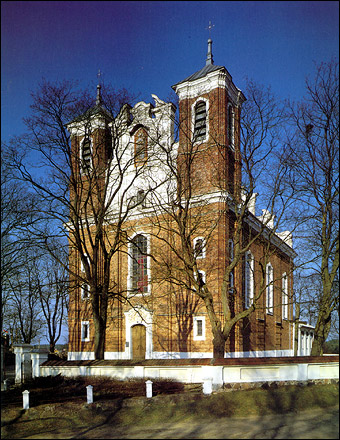 |
 |
 |
| |
|
|
|
|
|
OUR LADY OF SILUVA

MOTHER MARY COMES IN HER CHILDRENS DARKEST HOUR
Called "Lithuania's Greatest Treasure," Our Lady of Šiluva is a painting, and a church, but more than anything else she is the figurehead of Lithuania's unfailing Catholic faith during centuries of persecution, trial and hardship. On September 8, 1991, in a gesture of national and religious unity, Cardinal Sladkevicius and Vytautas Landsbergis, Chairman of the Parliament, entrusted Lithuania to the Immaculate Heart of the Blessed Virgin Mary.
THE PAINTING

The painting is of the Hodegetria type, i.e., Our Lady of the Way, and most probably one of the many copies of the famous Madonna Salus Populi Romani, located at Santa Maria Maggiore in Rome.
The painting was brought by Peter Gedgaudas from Rome in 1457. In 1770, Father Skivamantas had a gold dress made for Our Lady of Šiluva. The image was solemnly crowned in 1775. During the Calvinist period (1532-1608) the painting was hidden in an ironclad box buried deep in the ground.
THE CHURCH

Lithuania accepted Christianity in 1251. The Catholic faith was threatened repeatedly, not only during the Protestant Reformation (Calvinism, 1532) but also under the Czarist regime (dominance of the Orthodox Church), and again during the Communist domination (practical atheism).
The apparition of Our Lady in 1608--in many ways similar to that of La Salette (the apparition is silent and cries)--brought about a change in attitude and the conversion of many. The painting was miraculously retrieved. It was enshrined in the Basilica of the Blessed Virgin Mary and is venerated to this day as a miraculous image.
In 1624, a small wooden church was built on the site of the original chapel. It proved too small for the many pilgrims (11,000 on September 8, 1624). A much larger church was built and consecrated in 1651. The present Basilica of the Birth of the Blessed Virgin Mary is the fourth to have been built on the same location (1700-1786). The style is late Baroque, especially the interior decoration. Damaged by fire, the Church was rebuilt once again in 1924/25. The picture on the right is where the apparition of Mary stood.
www.udayton.edu/mary/resources/siluva.html
BACK TO
| HOME
| UPDATES
| GALLERIES
| FOUNDER
| SHOP
| INTERACT
| JOIN
US! © 2004 - 2006 RASA VON WERDER
|